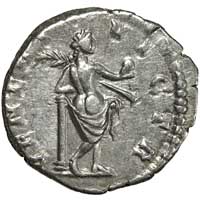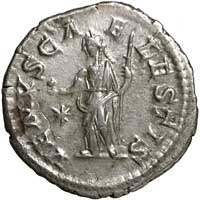| Home Page | Site Map | Useful Links | Email Me | Glossary | Next Page |
| ---------- The Sign Language of Roman Coins ---------- |
| Venus, Ancestress of Rome |
| You can click on any coin image to see the full coin. |
Venus was an integral part of the religious life of Rome, one of her major deities. In fact it is possible that she may have begun as an abstraction like Victory and Hope before becoming identified with the Greek Aphrodite. Her worship survived unofficially even into the Christian fourth century.
Aphrodite, and therefore also Venus, was regarded as an ancestress of the Roman people. Virgil's Aenead sets out how Aphrodite's son Aeneas fled the defeat of Troy to eventually settle in Italy, and how Romulus and Remus, founders of the city of Rome, were among his descendants.
The coin on the right was minted by the moneyer L. Memmius Galerius, known only from his coins and apparently from the less important branch of the Memmii. This denarius, from 106 BCE, shows Venus riding in a slow biga, with Cupid, her child, flying above carrying an open wreath. Venus is shown because she was the tutelary deity of the Memmii, who claimed descent from the Trojan Mnestheus, who accompanied Aeneas to Italy.
This coin is a serrate denarius, with a notched edge. Many Republican denarii were made like this. It might have been an attempt to discourage forgery, though there is no evidence that it actually did.
Towards the end of the Roman Republic, in the first century BCE, several powerful characters drew on this legend to claim Venus as their sponsor or protector. Sulla showed Venus on coins minted in the east, which he struck without the authority of the Senate, a gesture showing his independence and power. Pompeius Magnus, who was given his name "The Great" by Sulla, rivalled this by building a large combined temple and theatre complex on the Campus Martius in Rome which included a temple of Venus Victrix, Venus the victor, implying that it was through her help that he won his victories.
Although Pompeius supported Sulla, there was some rivary later in their association, and his supporters also showed Venus on their coins. Caius Norbanus, whose denarius on the near right from 87 BCE shows the head of Venus, was probably not a supporter of either, as his father of the same name had been on the other side in the recent Social War, and had lost a battle to Sulla in 83 BCE.
The coin on the far right is a coin from 41 years later, a denarius struck by Mn. Cordius Rufus in 46 BCE. The coin shows Venus holding a pair of scales and a tall sceptre. The small winged figure at her shoulder is her son, Cupid. This is Venus Verticordia, the changer of hearts, who protected against vice. A temple to Venus Verticordia was dedicated in 114 BCE, following a reading of Rome's Books of the Sybil, to atone for the inchastity of three Vestal Virgins. This was the Venus in whose honour the festival of Veneralia was held on 1st April.
46 BCE, when that last coin was struck, was a busy year for Julius Caesar. He was a consul that year, and it was the year in whch the Julian calendar was adopted. He improved on both Sulla's and Pompey's claims; his tribe, the Julii, claimed personal direct descent from Venus through Aeneas. (One of Caesar's "Venus" coins is on my want list.)
When Caesar built a new and imposing Forum, he centred it on a temple of Venus Genetrix, Venus the Ancestress of the Roman people, which was dedicated in that same year, 46 BCE. Venus Genetrix is also shown on this denarius of Julia Domna, here represented on the far left by a "limes" base metal version, probably a contemporary fake. Here, Venus is enthroned, holds a tall sceptre in her left hand, and holds out her right hand. The lovely-looking coin next to it is actually a modern replica of a denarius of Julia Paula; almost the same image, but on this coin Venus is holding an apple.
As was common in the Roman pantheon, Venus was not a single unified concept or entity. Venus Erycina was evoked from Mount Eryx in Sicily in 217, at the beginning of the second war with Carthage and its brilliant general Hannibal, after the Roman defeat at Trasimere. This "evocation" was a ceremony to bring an enemy deity over to the side of Rome. Most unusually for a foreign deity, she was given a temple inside the pomerium, on the Capitol. Cybele was also evoked into Rome and vowed a temple inside the pomerium during the same war, which shows how seriously Rome regarded the threat.
There must have been many statues of Venus spread around Rome. One was found in the temple of the Magna Mater in Ostia along with other Roman deities, linking the Magna Mater to the mainstream of Roman life. Augustus, the adopted son of Julius Caesar, placed a statue of Venus, his ancestress, in his temple of Mars Ultor. Later, Hadrian built a temple of Venus and Roma close to the Forum, dedicated in 121 CE. It had two chambers, one for each goddess. This time, Venus was associated, not with a particular dynasty, but with Rome as a whole. It was the first time Roma had a cult image in the city. To mark this temple's dedication, Hadrian added circus games to the ancient Parilia, which increased the popularity of that festival. This temple was still current and relevant in the early 4th century; it was restored by Maxentius around 306-312, after a fire.
Venus holds an apple on many of her coins, including the denarius of Faustina Junior above right. An apple would be a suitable love gift. A more romantic interpretation would make it the golden apple of Eris, goddess of discord. The story goes that Eris had not been invited to a banquet, and so she threw this apple into the group. On the apple was written "For the fairest one." The trouble provoked by this act, and the decision who should receive the apple, eventually caused the Trojan war.
On the same coin, Venus is also holding a rudder which has a dolphin twined around it. The rudder is an aspect of the Greek Tyche and her Roman equivalent, Fortuna, and usually means that the holder is guiding our fates. The addition of a dolphin might mean that in this case, it is simply a reference to the birth of Aphrodite from the sea.
Venus as a conqueror was not a classical representation, but was new to the Romans, possibly with a hint of some of the less refined characteristics of Aphrodite. The ancestor goddess was recruited to be behind the victories of the Roman emperors. This gave us coins with the legend VENVS VICTRIX, or sometimes VENERI VICTRICI meaning that the coin was dedicated to Venus the conqueror.
The denarius above left is not labelled as such, but is clearly the Victrix type, with one hand on the spoils of battle and the other holding out a small figure of Victory. The middle coin, an antoninianus of Caracalla, is the same type, and has the legend VENVS VICTRIX. The denarius of Julia Domna to its right has the same legend, but the image is slightly different; Venus is leaning on a column and is holding the palm branch of victory.
On the near right is probably the most sought after version of Venus on Roman coins. It's not hard to see why. She is seen from the back, nearly nude, her long spine and large buttocks clearly and lovingly depicted. But this is still Venus the conqueror - she still has the victor's palm, though she carries her apple rather than the helmet of an enemy. This is another denarius of Julia Domna, whose beauty is alluded to by the use of Venus as a coin type.
Next to it, on the far right, is the last Venus to appear on a Roman coin, on a bronze follis of Galeria Valeria, wife of the emperor Galerius. This lanky Venus is also the conqueror, according to the legend, though she is holding an apple and raising the shoulder of her garment, and does not have any of the trappings of victory about her.
Finally, a few variations on the theme. On the left, Venus Felix, happy and blessed. This is another denarius of Julia Domna.
The two denarii on the right are of Julia Soaemias, the mother of Elagabalus, showing Divine or Heavenly Venus. On the near right, she stands with a sceptre, holding out her apple, with a star next to her to emphasise her divinity. This was a common feature on coins of Elagabalus and his mother.
The denarius on the far right shows Venus Caelestis seated, still with her sceptre, with a child at her feet, which probably represents her son Cupid.
| ———————— Useful References ———————— |
These books provided some, but not all, of the information on this page. Thanks also to the contributors to the Forum Classical Numismatics Discussion Board, a group of people who are both helpful and knowledgeable.
A Dictionary of Roman Coins by Seth William Stevenson, F.S.A., C Roach Smith, F.S.A., and Frederic W. Madden, M.R.A.S. First published by George Bell and Sons, 1889. Reprinted by B A Seaby Ltd, London in 1964.
Religions of Rome: Volume 1, A History by Mary Beard, John North and Simon Price. Published by Cambridge University Press in 1998.
The Man in the Roman Street by Harold Mattingly, F.B.A. Published by the Numismatic Review, New York City in 1947.
These books are covered in a bit more detail on my page on coin reference books.
| The content of this page was last updated on 19 August 2008 |
| Home Page | Site Map | Useful Links | Email Me | Glossary | Next Page |













